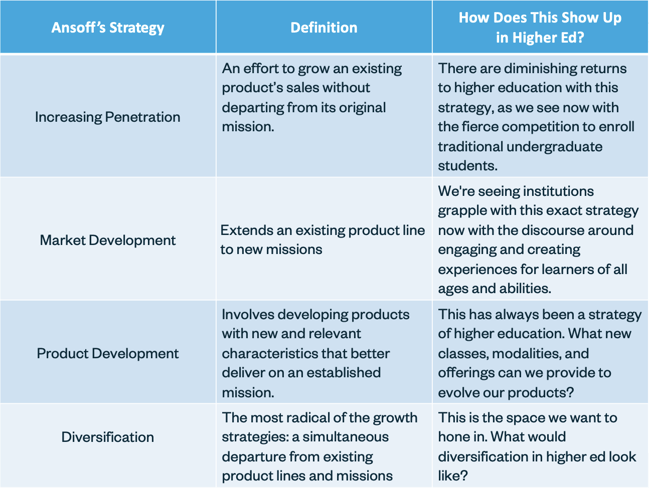Amid higher education's challenges, can we envision a brand that transcends conventional associations, fostering innovation and ensuring longevity? That is the question I had as I read Nick Liddel's recent piece about brand stretch in Branding Mag.
In the piece, Nick walks through Igor Ansoff's "Strategies for Diversification" matrix, which he introduced in 1957 and encompassed four growth strategies:

Higher education offers intriguing opportunities for diversification that may not be available to other out-of-category brands. For example, while some out-of-category brands can partially enter the higher ed space, most approach it transactionally, offering quicker and more affordable degrees than traditional colleges and universities. While this strategy allows them to develop their market, they fail to fully stretch into the higher ed space because of differing missions.
Our industry possesses a profound mission which makes the idea of diversification exciting. Traditionally centered around knowledge advancement and societal progress, we may have confined our perspective of how our mission comes to life too narrowly. Diversification allows us to explore unconventional avenues where that mission can come to life uniquely.
What does this look like in real life? Below are some of my favorite examples:

Arizona State University’s Brave New World Summit: The ASU GSV Summit is an annual education and workforce innovation, entrepreneurship, and investment conference. The summit is hosted by Arizona State University and GSV, or Global Silicon Valley, a venture capital firm that invests in education, talent, and related technology sectors.
Why it makes sense: With ASU's unwavering commitment to excellence, impact, and universal access, this summit presents a compelling opportunity to extend its brand into a new landscape, reinforcing ASU's association with accessibility and innovation at its core.
MIT’s Technology Review: This is a technology-oriented media company and magazine published by MIT. It covers the latest technological advancements, emerging trends, and their implications for various industries and society. The Technology Review has a wide swath of content, including a print publication and a network of podcasts.
Why it makes sense: MIT has established itself as a pioneer in technology and innovation, recognizing early on that it could be more than just an educational institution but also a hub for technology and innovation. Similar to ASU, the Technology Review further strengthens its identity as a technology-focused institution, aligning with its positioning in the field.
Global Preparatory Academy at Paul Quinn College: Paul Quinn College, an HBCU, partnered with the Dallas Independent School system to offer a unique education experience for students in underserved areas.
Why this makes sense: Paul Quinn is known for its strong commitment to education and community engagement. The program empowers underserved students with the essential skills for early success in higher education, fostering stronger connections and establishing Paul Quinn as a prominent leader in education and the community.
Penn State Berkey Creamery: The Penn State Creamery, founded in 1865, boasts a distinctive feature: it is entirely student-run and utilizes locally sourced ingredients. As its popularity has grown, the Creamery's reputation extends beyond the Penn State community. Notably, it operates both a retail store for in-person purchases and an online platform for sales, making it a unique and accessible destination for many.
Why it makes sense: Given Pennsylvania's prominence in the dairy industry, it's a natural place for Penn State to extend its brand. This endeavor supports student engagement and experience and positions Penn State at the forefront of its local community, adding to its appeal.
All these instances are firmly rooted in credible brand stretch endeavors that align with the mission of each institution. Each example enhances its respective institution's distinct brand identity and can bolster crucial objectives, including enrollment expansion, heightened brand recognition, and revenue diversification.
As much fun as it is to imagine that budget and resources aren't a thing to worry about, we need to think about the reality. Most institutions can't start a their own media company like MIT, but what small things can we do now to stretch brands?
- Embrace Mission-Centric Diversification: Institutions can explore diversification opportunities that align with their mission and core values. Identify areas where your institution's unique strengths and expertise can create innovative products and services that support the mission of higher education.
- Foster Interdisciplinary Collaboration: Encourage collaboration across different departments and disciplines within your institution. By breaking down silos and promoting cross-disciplinary cooperation, institutions can generate new ideas and approaches to brand stretch.
- Engage Stakeholders: Involve various stakeholders, including faculty, staff, students, alums, and community members, in brainstorming and discussing potential brand stretch initiatives. Gather diverse perspectives and insights to identify innovative ideas that resonate with your broader community.
- Leverage Technology and Digital Platforms: Explore using technology and digital platforms to enhance educational offerings and engage with a broader audience. To expand your institution's reach, consider launching online courses, webinars, virtual events, or educational content platforms.
- Implement Pilot Programs: Start with small-scale pilot programs to test new ideas before fully committing resources. Pilot programs provide valuable insights and feedback, allowing your institution to refine its brand stretch strategies before scaling up.
Higher education must explore fresh approaches to engage audiences and effectively communicate our stories and impact to achieve our goals, uphold our missions, and reshape perceptions. Embracing creativity and innovation is critical to demonstrating the actual value of higher education.
__
As Director of Insights, Emma is responsible for the development and delivery of actionable insights and meaningful data to SimpsonScarborough's higher education clients. She believes that data and information is not only critical to better branding and marketing strategies but to also advancing higher education. Emma currently lives in Knoxville, Tennessee where she enjoys hiking, trail running, biking, and brewery hopping.
